Note: This article first appeared in the Charleston Mercury. It is reprinted with permission.
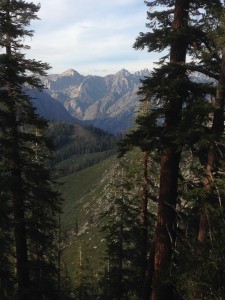
Canyon of the Middle Fork from the Monarch Divide.
The canyon of the Middle Fork of the Kings River in the Sierra Nevada is—to put it simply—magnificent. A world to itself in remoteness and grandeur; it has been described as a “primitive Yosemite”. The river is fed by snow melt and springs that originate on the peaks that surround Muir Pass and the even higher 14,000 foot Palisade Crest where the southernmost glaciers in North America rest. It’s crystalline; tumbling waters roar beneath towering domes and sheer granite walls. There are several trails and trackless canyons by which one can get there. None of them are easy; and to get out more difficult yet. Getting out is what became my challenge.
My wife, Allison, dropped me off on the eastern side of the Sierra near Bishop, California for what was to be an eight day solo backpacking trip. The Great Basin desert stretched out behind me beneath the rising morning sun as I made my way up one of the canyons that Mary Austin once referred to as the Streets of the Mountains. The Lodge pole and Jeffrey Pines, the aspens, and willows glistened, washed clean by the previous night’s rain. Since it was part of my three month sabbatical I was approaching the trip as a spiritual retreat; an octave. That alone explains why I made what was for me an unusual decision (which I only occasionally regretted)—I left my fly rod at home. Having visited earlier in the summer several beehive monastic sites of the early Celtic monks in Ireland I even called my domed backpacking tent my “beehive hut”.
The trip took me over three mountain passes the highest of which was 12,000 foot Muir Pass and 90 miles of trail—from the arid heights of the eastern Sierra to the magnificent coniferous forests of the western side—of which the renown English Botanist, Sir John Hooker, once told John Muir: “In the beauty and grandeur of individual trees, and in number of species, the forest of the Sierra surpasses all others.” The first half of my trek was over the high country of the Sierra but it was the second half of the trip for which I was most eager—for its rugged remoteness. This was after all primarily a silent retreat for my soul. I didn’t expect it to try both soul and body.
On day five I left the loveliness of Grouse Meadow and after an effortless mile and a half hike arrived at the junction of the Middle Fork and John Muir Trails. I forded a swiftly flowing Palisade Creek and started down the canyon toward Simpson Meadow. The fording brought to mind a word of warning from a trail crew I met in upper Le Conte Canyon. “How is the trail down to Simpson Meadow?” I asked. The response came quickly—“Spectacular but poorly maintained in places.” And then came an ominous warning from a trail worker shoveling sand—“Be careful fording the Middle Fork of the Kings at Simpson Meadow!”
The trail down the Middle Fork Canyon was breathtaking. Everywhere offering grand views both down the canyon as well as up toward the Sierra crest. It was one of the highlights of the trip for me. Each mile brought spectacular cliffs 4,000, to 5,000 thousand foot canyon walls and the river festooned with waterfalls, deep pools, raging rapids. But each impressive water fall or rapids made the words of warning echo in my ears—“Be careful fording the Middle Fork of the Kings!”
Just a mile or so past Devil’s Washbowl things took an ironic turn. As I rounded the talus rock of a side canyon there was a stench of smoke. I thought at first it was a simple campfire—but wondered who might be in the canyon and why they’d have a campfire on a rather warm afternoon. Too soon it was obvious this was no campfire but a forest fire.
The entire canyon was filling with smoke—above me, behind me, in front of me, down trail below me. My first thought was—“Where is the fire?” and the second—“What should I do?” Suddenly I heard a helicopter flying over Windy Cliff a granite wall some 4000 feet above me. Was the fire on the rim to the south? Was it on Granite Pass region? That would close off my route to Cedar Grove and the South Fork of the Kings River where Allison was to pick me up in three days? If so I would have to head down to Tehipite Valley and hike up the grueling canyon wall—a 3,000 foot ascent in a mile and a half over loose rock and sliding sandy soil. I had come down that trail in 1969 when I was 19 and was well aware of the demanding 30 miles of trail that route traverses.
Was the fire in the canyon itself? In that case I was walking into it. That too may cut off my way to Cedar Grove and this was complicated by the ominous fact that the wind was blowing up canyon toward me and may well mean I might not be able to hike faster than it spread so that I might need to take refuge in the river itself—no worries now about fording the Middle Fork!
Then there was the concern that if it was in the canyon it would mean I’d have to hike back the way I’d come, up and over two 12,000 foot passes which would be a three to four day hike. My overarching concern was Allison and how to get out in time (with no cell phone reception) to alleviate her fears if for some reason my route to Cedar Grove was blocked. My other concern was breathing the smoke was aggravating my sinuses and lungs and the longer I kept hiking the worse it would get. Weighing my options I decided to press on to Simpson Meadow and see if the trail had been posted in some way.
Once at the trail junction that leads up the canyon wall toward Granite Pass and the trailhead at Cedar Grove, I was standing beside the note-less trail sign wondering what to do. So I paused and prayed for guidance. To my astonishment just after finishing my prayer two backpackers came down the Granite Pass Trail. The fire they said was not up there. They hadn’t encountered smoke until they had come down into the canyon. So I had the information I needed. Having breathed the smoke for several hours I was not of a mind to stay. I would hike out.
It was late afternoon and I had already hiked over twelve miles that day. The trail up was a 5,000 foot ascent in five miles with no water source for over six and a half miles. The climb was relentless, the trail dusty, unrelentingly steep, poorly constructed. The only thing positive I can say about it is that it never had to lose altitude in order to gain it! By the time I got to the top of the ridge above Dougherty Meadow it was dusk. I began the descent, lost the trail as dusk yielded to darkness, and as one old packer once said of the Monarch Divide over which I was hiking: “It’s sure great up there. But it ain’t no place to be wandering around in the dark.” And in the dark I was; but hearing the creek I made my way to it.
In the darkness beside the creek I prayed and then looking up saw on a ledge above me what looked like a primitive campsite. It was—or a least someone had obviously stayed there before—and thank God it would do for the night. I pitched the “beehive” tent by the light of a headlamp and getting some water didn’t bother to cook dinner—to tired to be hungry. Mixed a sport drink and crawled into the tent (without the rain cover), ate a few slices of summer sausage and lay on my back looking up at the emerging stars. Several key moments during the day God had provided me the directives I needed (“some have entertained angels unawares”?). So while exhausted—my Fit-bit registered 46,936 steps and 20.59 miles— I just lay on my back and looked up at the stars in wonder.
I had spent the first half of the day’s hike concerned about a dangerous fording of the river with a forty pound backpack and then quite abruptly found myself concerned that I might have to take refuge in it from wildfire; I finished the last hours of the day parsimoniously sipping water as I hiked up a waterless, grueling ascent until my canteens were as dry as the tongue that stuck to the roof of my mouth—a day of ironies. Now as my watch noted 10:00 p.m. my thirst was quenched; and looking up at the wheeling sky the words of the psalmist described the movements of my soul:
O God, you are my God; eagerly I seek you;
my soul thirsts for you, my flesh faints for you
as in a barren and dry land where there is no water….
My soul is content, as with marrow and fatness,
and my mouth praises you with joyful lips.
When I remember you upon my bed,
and meditate on you in the night watches.
For you have been my helper, and under the shadow of your wings I will rejoice.
My soul clings to you; your right hand holds me fast. (Psalm 63)
It was a day of testing. T. S. Eliot was right when he wrote in the Four Quartets: “Old men should be explorers”—Explorers of the landscape— the geography of the physical world and the geography of the Spirit—of the inscape, the soul. While I could write of other days experiences on this hiking octave, day five brought what every true pilgrimage needs: fears, challenges, and blessings of earth, air, water and fire—a test for the body and refinement for the soul.

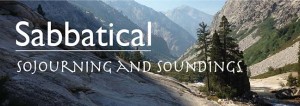


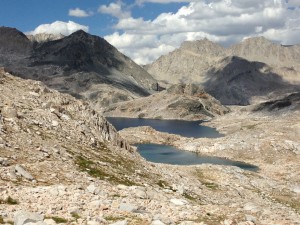
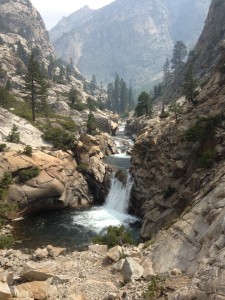
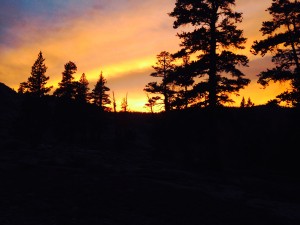

Most grateful for your comments! Most encouraging.
HI bishop Mark,
Love backpacking in Kings Canyon and have made several trips with Dean Carlos+ too.
Bless you heart for sharing. I could read your writings all day long. You make me feel as though I am there.
What an adventure and majestic scenery!
Thanks for journaling your challenges, thoughts and prayers along the journey.
I look forward to reading more.
Thanks so much for taking us on this wonderful adventure and encounter with nature and with our God.
Awesome, and so much time to listen and talk. It sounds like a wonderful time. I can’t wait to hear “The Rest of the Story”.
Beautifully written! felt as if i were right there with ya. felt that closeness to God you described and saw the beauty everywhere. Second only to my Irish father, you remain the best storyteller I know. y’all have been particularly on my mind the past couple of weeks, and now I know why, & always in my heart & prayers! Margaret